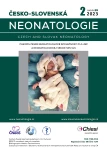Standardized procedure for stabilization and resuscitation of premature newborns
Authors:
T. Lamberská; K. Dunajová
Authors‘ workplace:
Oddělení neonatologie, Klinika gynekologie, porodnictví a neonatologie, 1. LF UK a VFN, Praha
Published in:
Čes-slov Neonat 2023; 29 (2): 86-91.
Category:
Contributions on respiratory problems of preterm newborns
Overview
Effective stabilization and resuscitation in the delivery room are essential for premature infants. As the gestational age of the infants decreases, the need for medical interventions increases. The European Consensus Guidelines on the Management of Respiratory Distress Syndrome recommendations reflect the current knowledge development in the postnatal transition of premature infants. However, there is no evidence targeting specific groups of extremely premature infants. Nevertheless, the implementation of targeted guidelines can benefit the most fragile newborns. This publication aims to provide the current recommendations from the European Consensus, supplemented with internal guidelines from the Neonatal intensive care units at the Department of Gynaecology, Obstetrics and Neonatology, First Faculty of Medicine, Charles University and General University Hospital in Prague, which are based on their data and experiences.
Keywords:
stabilization and resuscitation in the delivery room, extremely preterm infant, umbilical cord management, postnatal transition
Sources
- Sweet DG, Carnielli VP, Greisen G, et al. European consensus guidelines on the management of respiratory distress syndrome: 2022 update. Neonatology 2023; 120(1): 3–23
- Wyckoff MH, Singletary EM, Soar J, et al. 2021 International Consensus on Cardiopulmonary Resuscitation and Emergency Cardiovascular Care Science With Treatment Recommendations: Summary From the Basic Life Support; Advanced Life Support; Neonatal Life Support; Education, Implementation, and Teams; First Aid Task Forces; and the COVID-19 Working Group. Resuscitation 2021; 169 : 229–311.
- Lamberska T, Luksova M, Smisek J, et al. Premature infants born at <25 weeks of gestation may be compromised by currently recommended resuscitation techniques. Acta Paediatr 2016; 105(4): e142–e150.
- McAdams RM, Lakshminrusimha S. Management of placental transfusion to neonates after delivery. Obstet Gynecol 2022; 139(1): 121–137.
- Robledo KP, Tarnow-Mordi WO, Rieger I, et al. Effects of delayed versus immediate umbilical cord clamping in reducing death or major disability at 2 years corrected age among very preterm infants (APTS): a multicentre, randomised clinical trial. Lancet Child Adolesc Health 2022; 6(3): 150–157.
- Jasani B, Torgalkar R, Ye XY, Syed S, Shah PS. Association of umbilical cord management strategies with outcomes of preterm infants: a systematic review and network meta-analysis. JAMA Pediatr 2021; 175(4): e210102.
- Brouwer E, Knol R, Vernooij ASN, et al. Physiological-based cord clamping in preterm infants using a new purpose-built resuscitation table: a feasibility study. Arch Dis Child Fetal Neonatal Ed 2019; 104(4): F396–F402.
- Knol R, Brouwer E, van den Akker T, et al. Physiological-based cord clamping in very preterm infants: randomised controlled trial on effectiveness of stabilisation. Resuscitation 2020; 147 : 26–33.
- Koo J, Kilicdag H, Katheria A. Umbilical cord milking-benefits and risks. Front Pediatr 2023; 11 : 1146057.
- Al-Wassia H, Shah PS. Efficacy and safety of umbilical cord milking at birth: a systematic review and meta-analysis. JAMA Pediatr 2015; 169(1): 18–25.
- Katheria AC, Amino R, Konop JM, et al. Stem cell composition of umbilical cord blood following milking compared with delayed clamping of the cord appears better suited for promoting hematopoiesis. J Pediatr 2020; 216 : 222–226.
- Katheria A, Reister F, Essers J, et al. Association of umbilical cord milking vs delayed umbilical cord clamping with death or severe intraventricular hemorrhage among preterm infants. JAMA 2019; 322(19): 1877–1886.
- Donaldsson S, Drevhammar T, Taittonen L, et al. Initial stabilisation of preterm infants: a new resuscitation system with low imposed work of breathing for use with face mask or nasal prongs. Arch Dis Child Fetal Neonatal Ed 2017; 102(3): F203–F207.
- Donaldsson S, Drevhammar T, Li Y, et al. Comparison of respiratory support after delivery in infants born before 28 weeks‘ gestational age: the CORSAD randomized clinical trial. JAMA Pediatr 2021; 175(9): 911–918.
- Kuypers K, Martherus T, Lamberská T, et al. Reflexes that impact spontaneous breathing of preterm infants at birth: a narrative review. Arch Dis Child Fetal Neonatal Ed 2020; 5(6): 675–679.
- Kuypers KLAM, Hopman A, Cramer SJE, et al. Effect of initial and subsequent mask applications on breathing and heart rate in preterm infants at birth. Arch Dis Child Fetal Neonatal Ed 2023; 108(6): 594–598.
- Van Leuteren RW, Scholten AWJ, Dekker J, et al. The effect of initial oxygen exposure on diaphragm activity in preterm infants at birth. Front Pediatr 2021; 9 : 640491.
- Saugstad OD, Kapadia V, Oei JL. Oxygen in the first minutes of life in very preterm infants. Neonatology 2021; 118(2): 218–224.
- Lamberská T, Vaňková J, Plavka R. Efficacy of FiO2 increase during the initial resuscitation of premature infants <29 weeks: an observational study. Pediatr Neonatol 2013; 54(6): 373–379.
- White LN, Thio M, Owen LS, et al. Achievement of saturation targets in preterm infants <32 weeks’ gestational age in the delivery room. Arch Dis Child Fetal Neonatal Ed 2017; 102(5): F423–F7.
- Katheria AC, Hassen K, Rich W, et al. Resuscitation outcomes of infants that do not achieve a 5 min target SpO(2) saturation. J Perinatol 2019 Dec; 39(12): 1635–1639. doi: 10.1038/s41372-019-0491-x. Epub 2019 Sep 5. PubMed PMID: 31488904
- Oei JL, Finer NN, Saugstad OD, et al. Outcomes of oxygen saturation targeting during delivery room stabilisation of preterm infants. Arch Dis Child Fetal Neonatal Ed 2018; 103(5): F446–F454.
Labels
Neonatology Neonatal NurseArticle was published in
Czech and Slovak Neonatology

2023 Issue 2
Most read in this issue
- Non-invasive pulmonary ventilation of newborns in CPAP and HFNC mode
- Surfactant treatment
- Respiratory failure and ECMO in neonates
- Standardized procedure for stabilization and resuscitation of premature newborns
